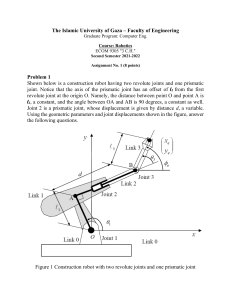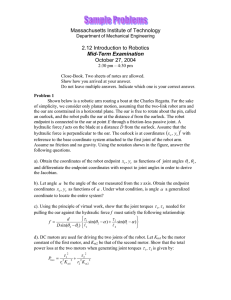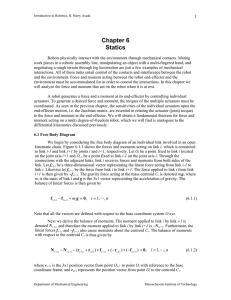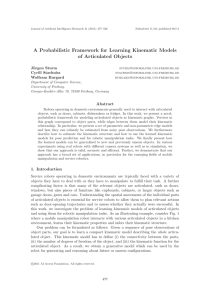Problem Set No.3
advertisement
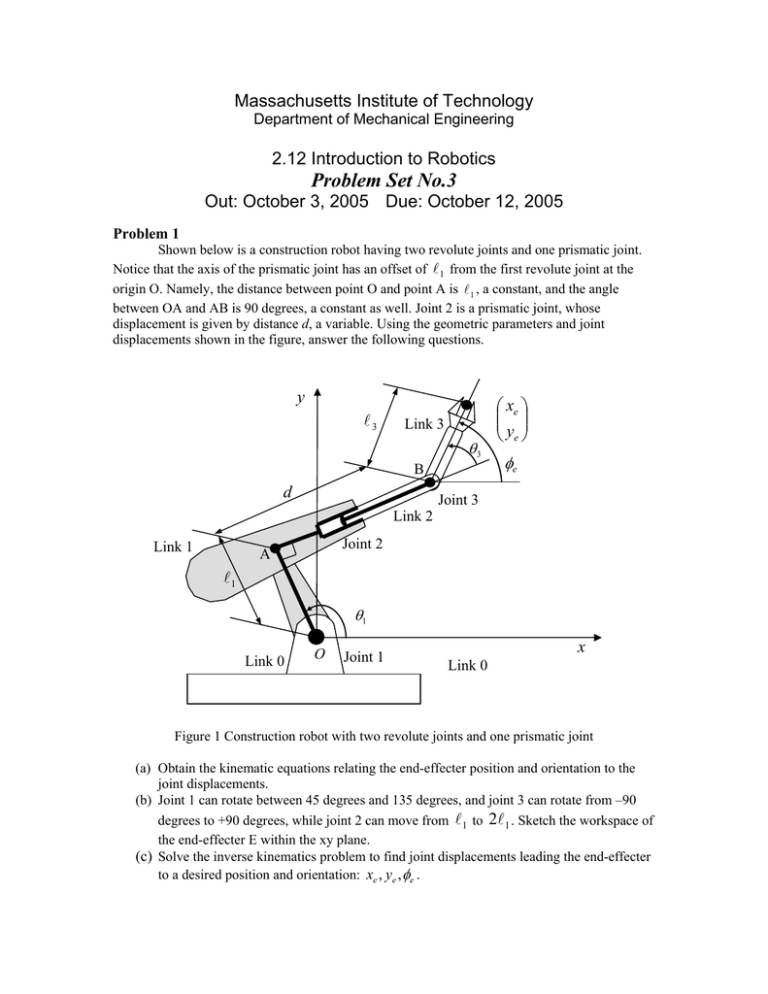
Massachusetts Institute of Technology Department of Mechanical Engineering 2.12 Introduction to Robotics Problem Set No.3 Out: October 3, 2005 Due: October 12, 2005 Problem 1 Shown below is a construction robot having two revolute joints and one prismatic joint. Notice that the axis of the prismatic joint has an offset of A 1 from the first revolute joint at the origin O. Namely, the distance between point O and point A is A 1 , a constant, and the angle between OA and AB is 90 degrees, a constant as well. Joint 2 is a prismatic joint, whose displacement is given by distance d, a variable. Using the geometric parameters and joint displacements shown in the figure, answer the following questions. y A3 Link 3 θ3 B d ⎛x ⎞ ⎜⎜ e ⎟⎟ ⎝ ye ⎠ φe Joint 3 Link 2 Link 1 Joint 2 A A1 θ1 Link 0 O Joint 1 x Link 0 Figure 1 Construction robot with two revolute joints and one prismatic joint (a) Obtain the kinematic equations relating the end-effecter position and orientation to the joint displacements. (b) Joint 1 can rotate between 45 degrees and 135 degrees, and joint 3 can rotate from –90 degrees to +90 degrees, while joint 2 can move from A1 to 2A1 . Sketch the workspace of the end-effecter E within the xy plane. (c) Solve the inverse kinematics problem to find joint displacements leading the end-effecter to a desired position and orientation: xe , ye , φe . Problem 2 Shown below is the schematic of a three dof articulated robot arm. Although this arm looks three-dimensional, its kinematic equations can be obtained in the same way as that of planar robots. For joints 2 and 3 alone, consider a vertical plane containing links 2 and 3. As for joint 1, consider the projection of the endpoint onto the xy plane. Answer the following questions, using the notation shown in the figure. (a) Obtain the kinematic equations relating the endpoint coordinates, xe , ye , ze , to joint angles θ1 ,θ 2 ,θ 3 . (b) Solve the inverse kinematics problem, i.e. obtain the joint coordinates, given the endpoint coordinates. Obtain all of the multiple solutions, assuming that each joint is allowed to rotate 360 degrees. (c) Sketch the arm configuration for each of the multiple solutions. z Endpoint A2 Link 3 θ3 ⎛ xe ⎞ ⎜ ⎟ ⎜ ye ⎟ ⎜z ⎟ ⎝ e⎠ A1 Joint 3 Link 2 θ2 Joint 2 y θ1 Link 1 x Joint 1 Figure 2 Schematic of 3 dof articulated robot arm Problem 3 Shown below is a robot arm with three revolute joints. Coordinate system O − x0 y0 z0 is fixed to Link 0. Axis x1 is fixed to Link 1. Joint angle θ1 is measured about the joint axis OA (z0 axis) from x0 to x1 . The second joint axis BC is horizontal, and joint angle θ 2 is measured from axis x1 to axis x2 , which is fixed to Link 2, as shown in the figure. Joint angle θ 3 is measured about the joint axis CD from axis x2 to Link 3,i.e. line DE. Link dimensions are OA=1, AB=1, BC=1, CD=0, and DE=1. (For the purpose of explaining the kinematic structure, points C and D are shown to be different points, but they are the same, i.e. the length CD is zero.) Note also that ∠OAB = ∠ABC = ∠BCD = ∠CDE = 90o . Answer the following questions. D Link 3 θ3 z0 θ2 A Link 2 E θ3 C θ2 θ1 B x1 x2 Link 0 O x0 y0 θ1 Figure 3 Kinematic structure of 3 DOF robot a). Obtain the coordinates of point C viewed from the base coordinate system O − x0 y0 z0 . b). Assuming that all the joints are allowed to rotate 360 degrees, determine the workspace of the robot. Sketch the workspace envelope, and show the size and dimensions of the envelope in your sketch.
